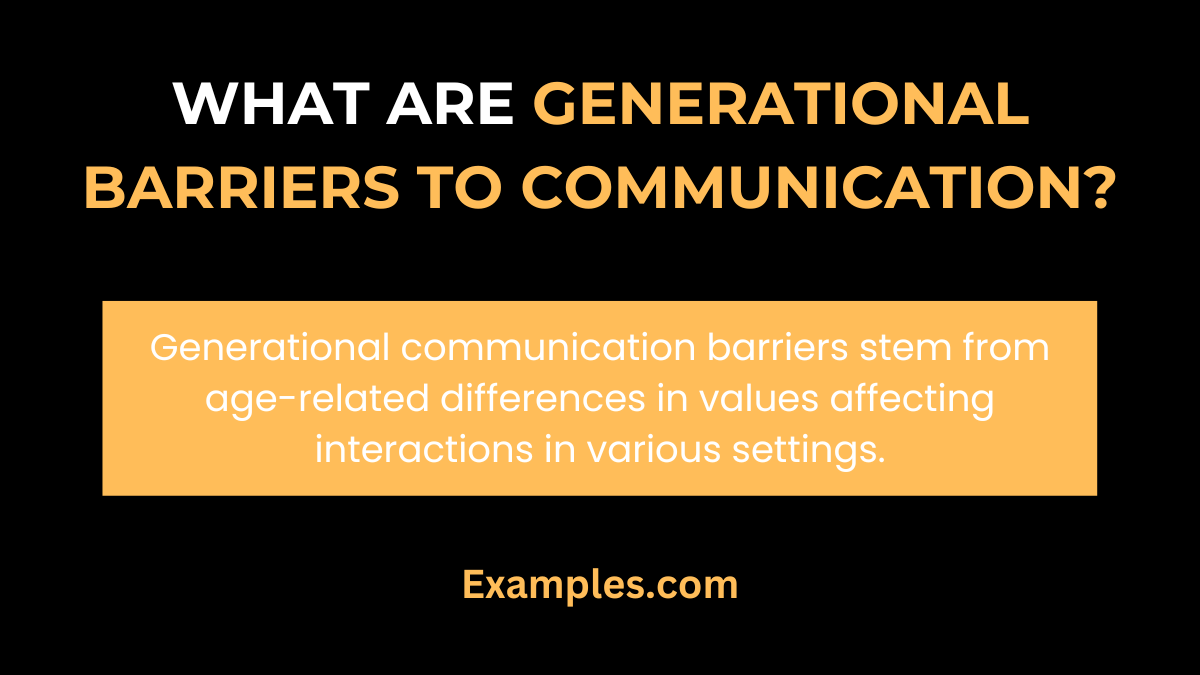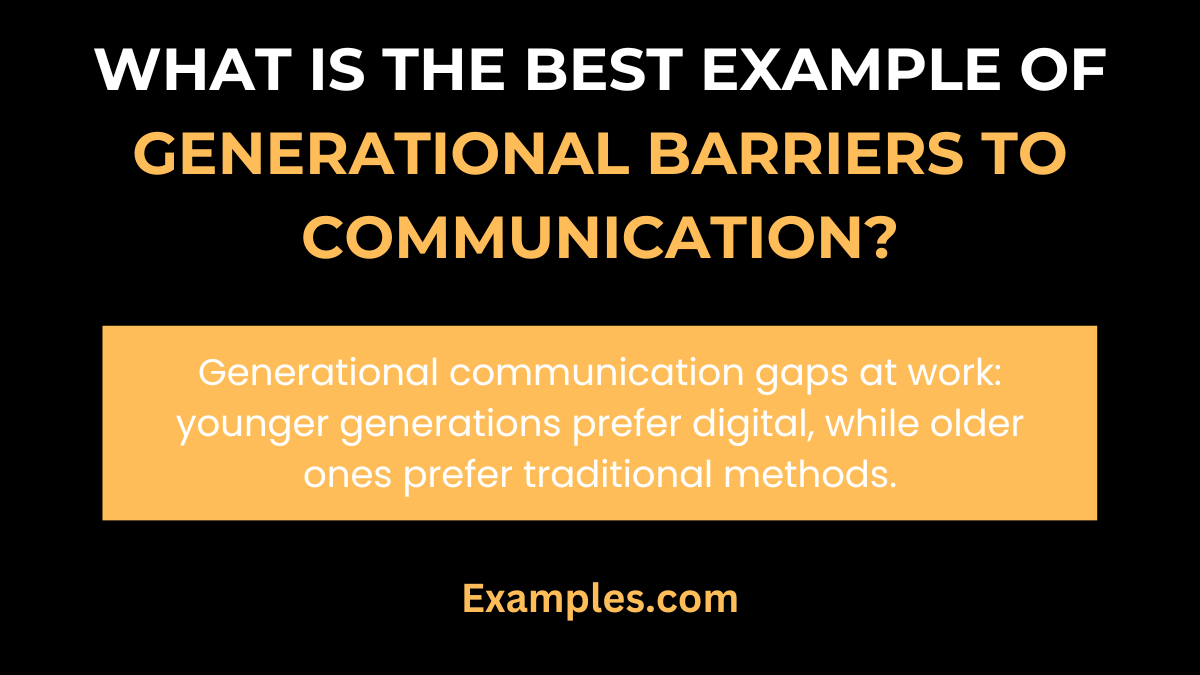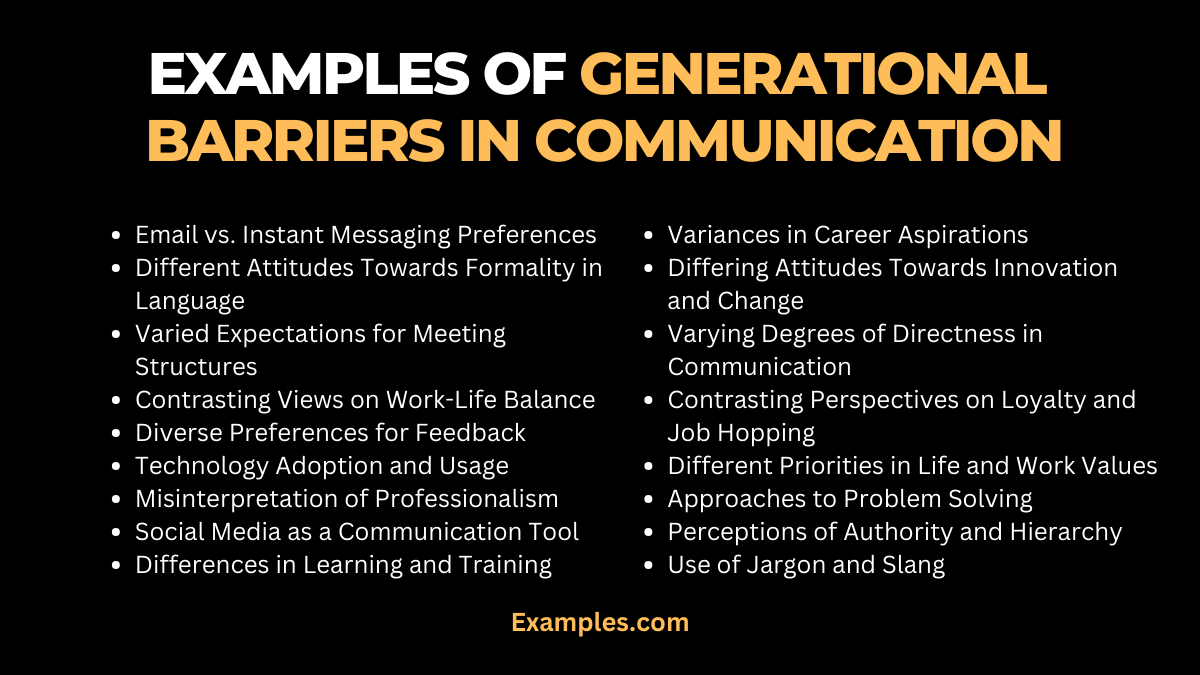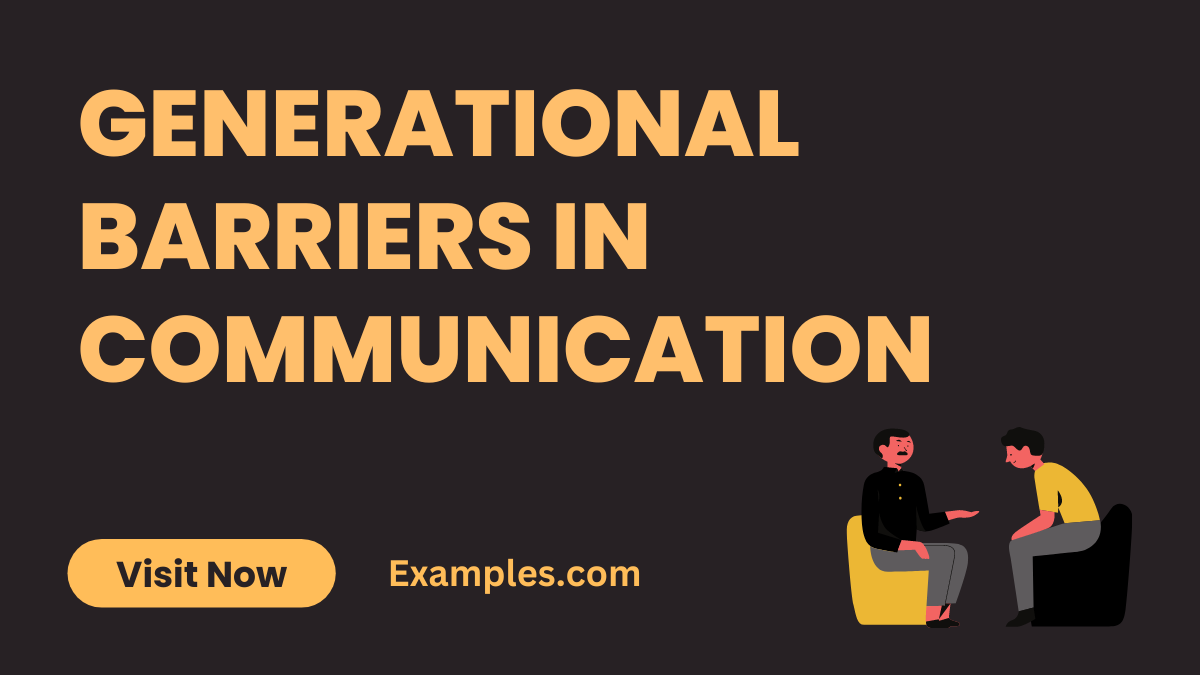19+ Generational Barriers in Communication Examples
In today’s diverse workplaces and social settings, Generational barriers in Communication pose a unique challenge. These barriers, stemming from differences in experiences, values, and technology use among various age groups, can lead to misunderstandings and decreased productivity. Addressing these barriers is essential for creating a more harmonious, effective communication environment, where knowledge and ideas are exchanged freely across generations.
What are Generational Barriers to Communication?

Generational barriers to Communication refer to the challenges that arise when individuals from different age groups interact and communicate. These barriers are often rooted in generational differences in perspectives, values, and communication preferences. Understanding and respecting these differences is crucial for effective communication in multi-generational environments such as the workplace, educational institutions, and family settings.
What is the Best Example of Generational Barriers to Communication?

A common example of Generational barriers to Communication is the differing preferences in communication methods between younger and older employees in a workplace. While younger generations may prefer quick, digital communication methods like instant messaging or emails, older generations might favor more traditional methods, such as face-to-face meetings or phone calls. Recognizing and adapting to these preferences is key to effective communication across generations.
20 Examples of Generational Barriers in Communication

In today’s diverse workplace and social environments, Generational barriers in Communication pose unique challenges. These barriers arise from differences in technological proficiency, communication styles, and workplace expectations across generations. Addressing them is essential for ensuring effective and inclusive communication. This guide presents 20 distinct examples of generational communication barriers, each with an explanation and suggested communication strategies, demonstrating how to navigate these challenges for better understanding and collaboration.
- Email vs. Instant Messaging Preferences: Older generations prefer emails, while younger ones opt for instant messaging.
Example: “Could we discuss this over email for detailed documentation?” - Different Attitudes Towards Formality in Language: Younger employees use casual language, whereas older colleagues favor formality.
Example: “I appreciate your informal approach, but let’s maintain a formal tone for client communications.” - Varied Expectations for Meeting Structures: Older employees value structured meetings; younger workers prefer quick stand-ups.
Example: “Let’s have a brief stand-up now and a detailed meeting later.” - Contrasting Views on Work-Life Balance: Younger staff prioritize flexibility, unlike their older counterparts.
Example: “I understand your need for work-life balance; let’s find a middle ground.” - Diverse Preferences for Feedback: Older generations may prefer less frequent, formal feedback, unlike younger ones.
Example: “Would you prefer weekly feedback sessions or a monthly review?” - Technology Adoption and Usage: Younger employees are tech-savvy, while older ones may be less so.
Example: “Let me help you with this new software.” - Misinterpretation of Professionalism: Different generations have varying perceptions of professionalism.
Example: “Our definitions of professionalism may vary, but let’s respect each viewpoint.” - Social Media as a Communication Tool: Younger employees use social media for communication, which older generations might not.
Example: “I noticed your message on LinkedIn; can we also communicate via email?” - Differences in Learning and Training Styles: Younger workers favor interactive, digital learning, unlike older employees.
Example: “Would you be comfortable with an online training module?” - Variances in Career Aspirations: Career goals and aspirations differ across generations.
Example: “Let’s discuss your career goals and how we can align them with our objectives.” - Differing Attitudes Towards Innovation and Change: Younger generations are often more open to change than older ones.
Example: “Your experience is valuable; let’s also consider these new approaches.” - Varying Degrees of Directness in Communication: Older generations might be more direct than younger ones.
Example: “I appreciate your directness, and let’s ensure everyone feels comfortable.” - Contrasting Perspectives on Loyalty and Job Hopping: Older generations value job stability more than younger ones.
Example: “I understand your concern about job hopping; let’s discuss long-term career paths.” - Different Priorities in Life and Work Values: Life and work values can differ greatly across generations.
Example: “It’s interesting to see our different priorities; let’s find common ground.” - Approaches to Problem Solving: Younger employees may prefer collaborative problem-solving, unlike older colleagues.
Example: “Your individual approach is great; could we also try a team brainstorming session?” - Perceptions of Authority and Hierarchy: Older employees might respect hierarchy more than younger ones.
Example: “While I respect the hierarchy, I also value everyone’s input.” - Use of Jargon and Slang: Misunderstandings arise from generational differences in language.
Example: “This term might be new to you; it means…” - Expectations for Autonomy and Guidance: Younger workers often seek autonomy, unlike older generations.
Example: “I respect your desire for autonomy; let me know if you need guidance.” - Differences in Communication Frequency: Older generations may not require constant updates like younger ones.
Example: “Would you prefer daily updates or a weekly summary?” - Contrasts in Decision-Making Processes: Older employees might favor a methodical approach, unlike younger ones.
Example: “Your quick decision-making is great; let’s also consider a detailed analysis.”
Recognizing and adapting to these Generational barriers in Communication is key to fostering a collaborative and inclusive environment.
Workplace Generational Barriers in Communication
In the modern workplace, Generational barriers in Communication often stem from differing values, experiences, and technological preferences across age groups. These barriers can affect teamwork, productivity, and employee satisfaction. Understanding and addressing these challenges is crucial for creating a cohesive and effective work environment. Here are ten examples illustrating how generational communication barriers manifest in the workplace:
- Preference for Different Communication Tools: Older employees may prefer emails or phone calls, while younger staff might lean towards instant messaging or social media platforms.
- Varied Approaches to Feedback: Younger generations often seek immediate, regular feedback, whereas older generations might prefer formal, less frequent reviews.
- Differing Work-Life Balance Expectations: Younger workers often prioritize flexibility and work-life balance more than older colleagues.
- Contrasting Attitudes Toward Authority: Older employees might value hierarchical structures, while younger ones favor a more collaborative approach.
- Technology Adaptation and Training: Younger employees are typically more comfortable with emerging technologies compared to older counterparts who may require more training.
- Differences in Career Goals and Aspirations: Generational differences can influence career priorities and expectations.
- Misunderstandings Due to Language and Jargon: Use of contemporary slang or technical jargon can alienate some generational groups.
- Diverse Perspectives on Professional Development: Younger employees might seek opportunities for growth and skill development, while older employees may focus on stability and expertise sharing.
- Varied Preferences for Meeting Styles and Frequencies: Older generations might prefer in-person, structured meetings, whereas younger generations may favor informal or virtual gatherings.
- Differences in Feedback and Recognition Styles: Generations differ in how they prefer to receive recognition and feedback, with some preferring public acknowledgment and others valuing private appreciation.
Addressing these Generational barriers in Communication is key to fostering an inclusive, productive workplace environment.
Strategies of Generational barriers in Communication
Navigating Generational barriers in Communication requires thoughtful strategies that respect and leverage the strengths of each age group. By understanding these barriers, we can foster a more inclusive and effective communication environment across generations.
- Foster Mutual Respect: Encourage respect for different generational perspectives.
- Customized Communication: Tailor communication styles to suit different age groups.
- Technology Training: Provide training on new communication technologies.
- Encourage Mentorship Programs: Pair different generations for knowledge exchange.
- Regular Feedback Sessions: Hold sessions for sharing feedback across ages.
- Flexible Work Policies: Adapt to different work styles and preferences.
- Celebrate Diversity: Recognize and celebrate generational diversity.
- Promote Collaborative Projects: Encourage intergenerational collaboration on projects.
How to Bridge Communication Gaps Between Generations
Bridging communication gaps between generations is essential in creating an environment where all age groups can thrive and communicate effectively.
- Understand Generational Differences: Be aware of different communication preferences.
- Create Inclusive Meetings: Ensure all generations are represented and heard.
- Use a Variety of Communication Tools: Incorporate both traditional and modern tools.
- Encourage Open Dialogue: Promote open discussions about communication preferences.
- Adapt to Learning Styles: Respect different learning and teaching styles.
- Provide Cross-Generational Training: Offer training that appeals to all ages.
- Develop Clear Communication Policies: Create policies that consider all generations.
- Utilize Mixed-Age Teams: Foster teamwork among different age groups.
Effectively navigating Generational barriers in Communication is crucial in today’s diverse environments. By understanding and respecting different communication styles, embracing technological advancements, and fostering inclusive dialogue, we can bridge generational gaps. This guide serves as a valuable tool in enhancing intergenerational understanding and collaboration, ensuring that communication remains effective and respectful across all age groups.



